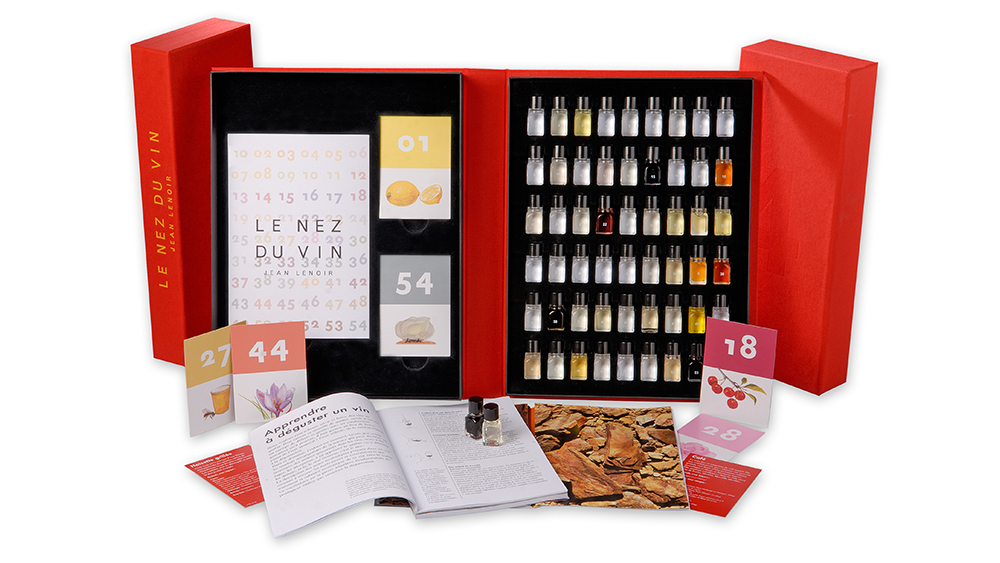People often ask me how I can be sure that the aromas I say I smell are what they are and not another. “Is it really strawberry instead of raspberry?” they ask.
I can understand why people feel the need to ask this question. All too often, wine aromas are confused or misinterpreted, making it difficult to identify the wine being described. So, just how does one learn to accurately distinguish and describe wine aromas?
In my professional opinion and based on my personal experience, the simplest way to learn to differentiate the aromas in wine is by using the Wine Aromas’ (Le Nez du Vin) wine education kit developed by Jean Lenoir. But we’ll return to that later. For now, let’s discuss where wines get their aromas, and how professional wine tasters describe wine aromas and why they describe them this way.
Where Wines Get Their Aromas
Wines, or more specifically the grapes used to make wines, take on the characteristics of their environment (in wine speak, that’s terroir). In the earth (i.e. soil), air and water are aromatic compounds. The soil and water also contain the essences of plant and floral life that have been layered over through the centuries. These are the exceptional aromas found in red and white wines from France and around the world.
A wine’s aromas can give us an indication of this wine’s country, region and vineyard of origin. They also tell us about the grape varietal/s used to make the wine, the wine-making techniques utilized and the aging conditions to which the wine has been subjected.
An Explanation of Wine Aromas and How Wine Tasters Describe Them
When professional wine tasters say they detect the strawberry aroma in a particular wine, they are not saying that the maker of the wine added strawberry essential oils to the grape juice (i.e. that the wine is a strawberry-flavored one). They are simply saying that the wine has a scent that closely resembles that of strawberries.
In truth, wines owe their aromas from their chemical composition. It is not just one chemical compound that can lead to a particular aroma, moreover. A specific wine aroma can be a result of one or a combination of several compounds. For instance, there are a number of compounds (individually or in combination) that can give wines strawberry-like aromas – and these include Furaneol, ethyl acetate, ethyl butyrate, ethyl for mate, ethyl hexanoate, and methyl cinnamate.
Professional wine tasters, however, do not mention these compounds in their wine reviews. For example, they simply say they smell strawberries instead of saying the wine has Furaneol or any of the other compound with which the strawberry aroma is generally associated. This makes it easier for the readers of wine tasting notes to assimilate and use the provided information in their wine buying decisions. What professional wine tasters do, basically, is assess a wine’s aromas and describe them in a manner that laypersons (non-professionals) can easily understand.
Example:
Isn’t it easier to imagine how a wine would be like if we read a tasting note that describes it using words in our everyday vocabulary? Take the following sample description of a Nuits-St-Georges Premier Cru:
This red wine, garnet in color with pinkish meniscus, has the aromas of strawberry, raspberry, cherry, and liquor rice with some smoky notes. The wine is balanced with a smooth lingering finish.
The above description is clear, simple and very easy to understand, right? Now, imagine how so much more complicated and unfathomable this review of Nuits-St-Georges Premier Cru would be if wine tasters wrote the following way:
This red wine, garnet in color with pinkish meniscus, has the aromas of one or more of the following: Furaneol, ethyl acetate, ethyl butyrate, ethyl for mate, ethyl hexanoate, methyl cinnamate (Strawberry), ethyl acetate, ethyl for mate and esters (Raspberry), Benzaldehyde-cyanohydrin (Cherry), Glycyrrhyzin (Liquorice), Guaiacol, and 4-ethylguaiacol (Smoke). The wine is balanced with a smooth lingering finish.
Is your head aching yet? With a description like the above, only someone with a degree in chemistry could possibly imagine what this wine smells like. Any wine taster that writes his tasting notes this way will quickly (and deserves to) lose all of his readers, subscribers and followers.
The Wine Aromas Wine Education Kit
Now, let’s go back to our original question. Just how do we learn to distinguish and name specific wine aromas? The answer is simple: use the Wine Aromas (Le Nez du Vin) wine education kit.

The Wine Aromas (Le Nez du Vin) wine education kit is an essential tool for anyone who wishes to learn how to accurately identify specific aromas in wine. Through its help (and with time and practice), you will learn the universal language of wine, become skilled at accurately pinpointing wine aromas, and become good at identifying the type and origin of whichever wine you are sampling. Ultimately, the Wine Aromas wine education kit will improve your appreciation for wines.
For more information about Wine Aromas/Le Nez du Vin, please visit www.winearomas.com or check out the video about Le Nez du Vin on our video page.
Cheers!
Disclaimer: Sébastien Gavillet (the author of this article) is the Chief Wine Officer of Wine Aromas Inc, the official distributor of Le Nez du Vin wine education kits.